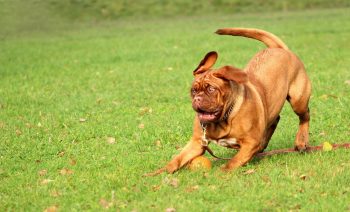Mastiffs, known for their impressive size and gentle nature, are among the largest breeds in the canine world. Despite their size, they have moderate exercise needs that are crucial for their health and well-being. This article will discuss the optimal amount and types of exercise for a Mastiff to ensure they lead a balanced and healthy life.
1. Assessing Mastiff Exercise Requirements
Mastiffs require moderate exercise, typically about 30 minutes to an hour per day. This should be low-impact to accommodate their large size and avoid stress on their joints.
2. The Health Implications of Exercise for Mastiffs
Regular exercise is essential for maintaining a Mastiff’s health, helping to manage their weight and prevent joint issues. It also aids in digestion, promotes cardiovascular health, and contributes to their overall mental well-being.
3. Appropriate Exercise Activities for Mastiffs
Walking at a steady pace is ideal for Mastiffs, along with opportunities for off-leash play in a secure area. They may also enjoy short sessions of gentle play, such as tug-of-war, and mentally stimulating activities like scent games.
4. The Role of Mental Stimulation in a Mastiff’s Exercise Regime
Mental stimulation is important for Mastiffs, who can be quite intelligent. Training exercises, puzzle feeders, and new experiences can keep their minds active and prevent boredom.
5. Balancing Exercise with Proper Rest
Due to their size, Mastiffs need ample rest periods between exercise sessions. Ensuring they have a comfortable place to sleep and recover is as important as the exercise itself.
6. Adapting Exercise to Your Mastiff’s Age and Health
Puppies and senior Mastiffs have different exercise needs than adults. Puppies require shorter, more frequent periods of play, while seniors need gentle, regular activity to maintain their mobility without overexertion.
7. Exercise in Different Climates
Mastiffs can be sensitive to extreme heat due to their heavy body mass. Exercise routines may need to be adjusted based on the weather to ensure they do not overheat.
8. Recognizing the Signs of Over-Exercise in Mastiffs
It’s important to recognize the signs of over-exercise in Mastiffs, which include excessive panting, reluctance to move, and lethargy. Adjust the exercise routine if any of these signs are observed.
9. Socialization and Exercise
Socializing your Mastiff during exercise, like on walks or during playdates, can help them become well-rounded adults. Mastiffs are generally good-natured but benefit from regular, positive interactions with other dogs and people.
10. Monitoring Your Mastiff’s Health Through Exercise
Regular exercise is an excellent way to keep an eye on your Mastiff’s health, as changes in their willingness to exercise or in their abilities can be early indicators of health issues.
Conclusion
Mastiffs are majestic creatures that require a dedicated exercise routine tailored to their unique needs. While they do not require the extensive exercise that some smaller, more energetic breeds do, they still benefit greatly from regular, moderate physical activity and mental challenges. Always consult with a veterinarian to ensure that your Mastiff’s exercise plan is appropriate for their age, health, and individual needs.
Frequently Asked Questions About Exercising A Mastiff
1. How much exercise does a Mastiff need each day?
Mastiffs require moderate exercise, usually totaling about 30 minutes to an hour daily. This should be low-impact, like leisurely walks or gentle play, to suit their large size and prevent joint stress.
2. What types of exercise are suitable for a Mastiff?
Suitable exercises for Mastiffs include leisurely walks, free play in a secure area, and interactive games that provide mental stimulation. They also benefit from training sessions that work on obedience and reinforce positive behavior.
3. Are long walks good for Mastiffs?
While Mastiffs enjoy walking, long walks should be approached with caution. Given their size, they can be prone to overheating and joint issues, so multiple shorter walks are better than one long walk, especially in warm weather.
4. Can Mastiffs participate in dog sports?
Mastiffs can participate in certain dog sports tailored to their capabilities, such as cart-pulling or weight-pulling, which allow them to exercise at a steady pace without high impact on their joints.
5. How do I know if my Mastiff is getting enough exercise?
Signs that your Mastiff is getting enough exercise include a healthy weight, a calm demeanor at home, and the absence of destructive behaviors. A Mastiff with pent-up energy may become restless or engage in inappropriate chewing or digging.
6. What are the signs of over-exertion in Mastiffs?
Signs of over-exertion in Mastiffs include excessive panting, difficulty getting up or laying down, reluctance to move, and signs of discomfort during or after exercise. If these signs occur, rest your Mastiff and consult your vet.
7. Is swimming a good exercise for Mastiffs?
Swimming can be excellent exercise for Mastiffs, offering a good workout without stressing their joints. Always supervise them around water, as not all Mastiffs may be natural swimmers.
8. How can I exercise my Mastiff during hot weather?
In hot weather, exercise your Mastiff in the early morning or evening when temperatures are cooler. Keep exercise sessions short, provide plenty of water, and avoid asphalt that can burn their paws.
9. What indoor exercises can I do with my Mastiff?
Indoor exercises can include hide-and-seek, gentle tug-of-war, and training new commands or tricks. These activities help keep a Mastiff engaged when outdoor conditions are not suitable for exercise.
10. At what age can I start more structured exercise with my Mastiff puppy?
Structured exercise with a Mastiff puppy, like planned walks or obedience training, can begin after they’ve received their vaccinations and the vet approves. However, it’s important to keep exercise gentle and short to protect their developing bones and joints.
The post How Much Exercise Does a Mastiff Need? appeared first on iHeartDogs.com.

